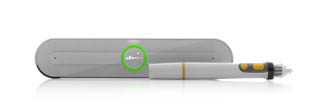Luidia's eBeam Edge - Setting the standard for interactive whiteboards

I've had an eBeam Edge sitting in a box in my office for a while now, waiting for me to unpack it and give the interactive whiteboard tool a test drive. This past weekend, I finally broke it out and I'm glad I did. At first blush, it reminded me of a small version of the early Mimio bars that attached with suction cups to any whiteboard and allowed capture of drawn content. Although Mimio devices have come a long ways, at the time (almost 5 years ago), our experience with them was pretty negative. Fortunately, the eBeam is vastly more sophisticated than the old Mimios and, more importantly, is supported by great software.

For me, the Edge will live in my laptop bag, along with extra Command strips and a micro portable projector. Since the interactive whiteboard components interface so easily with virtual classroom applications (and, in fact, Luidia offers their own free synchronous whiteboarding solution to customers), a complete e-teaching setup can fit in one main pocket of my small messenger bag.
There are a few things other than size that set the eBeam apart from other interactive whiteboard solutions. The most important is speed and accuracy. A quick calibration routine (tap 9 spots with the stylus in order) accessed from a virtual button the software places on the projected desktop, and you can have an interactive whiteboard up to 100" diagonally on virtually any surface. From there, you can write on the native projected whiteboard or any other application that accepts mouse/tablet input using the stylus in near real time. Annotating a PowerPoint slide, for example, with written text, equations, underlines, arrows, and highlighting with none of the lag that often accompanies interfaces of this type.
The second is the software itself. While SMART and Promethean are the undisputed masters of prepared content for their interactive whiteboards, Luidia has focused on an incredibly intuitive interface for everything from drawing and annotation to mouse control with their stylus. The teacher in the image above (OK, she's probably not a real teacher, but it's a good marketing photo of the software in action) has the stylus resting on the palette that controls virtually all of the stylus capabilities. With simple taps, the palette shifts from straight mouse control to highlighting (including color selection) to drawing (including color and line size selection) to calibration. Many other functions are included in the icon-based palette as well, but it never feels cluttered. The palette also features adjustable transparency, so the instructor can make it more or less obvious based on need.
eBeam hardware comes with Workspace software (essentially an overlay of interactive features on any desktop application, including tablet-style input to touch-aware applications), Capture software (for building presentations and capturing either still shots of the projection or recording movies of the content loading on the whiteboard), and Scrapbook (for creating archives, organizing and sharing screen shots, building e-learning courseware, etc.). These launch automatically (or prompt the user to launch them) based on user actions and work across Windows, Mac, and Linux (there are currently some limitations on OS X and Linux, in particular a lack of Lion support). The software also supports interactive Flash content, including prebuilt widgets from Luidia (virtually any other Flash modules can be loaded into the Scrapbook.
The hardware isn't cheap, but is competitive with Mimio; prices for systems hover around $1000 and schools/teachers will need to have a projector and computer in place. However, because an in-room PC is commonplace and projectors are increasingly ubiquitous, the Edge allows for easy use of existing whiteboard and projection resources without investing in expensive, full-blown interactive whiteboards.
For schools looking at more permanent installations, Luidia offers similar technology in fixed "digital-ready" whiteboards, short-throw mounted projectors, and multi-projector "InfoWall" setups.
Interestingly, Luidia also recently announced a partnership with Polycom to add their interactive whiteboard technologies to video conferencing installations. They also just announced a new partnership with NEC to layer not only their interactive capabilities on NEC mounted projectors but also to provide real-time whiteboard sharing and collaboration for distance and hybrid education using their synchronous technologies. This sort of industry traction certainly suggests some long-term viability, but more significantly, demonstrates the flexibility and utility of the core technology.
This is starting to read a bit like Luidia marketing schtick, but only because I was incredibly impressed with the usability and quality of the eBeam Edge. If I were looking at whiteboard solutions in a school at this point, I'd skip expensive, heavy interactive whiteboards and just leave big blank walls, ready for eBeams that can be purchased, deployed, and used as budgets allow for far less money and far greater whiteboard real estate than any smartboard manufacturer can currently match. The Edge has officially made my list of dead-finger tech (the hardware and software that you'd need to pry from my cold, dead hands if you wanted me to give it up).